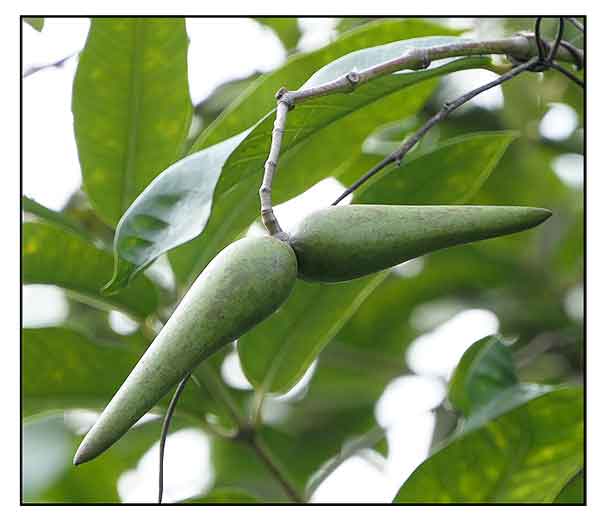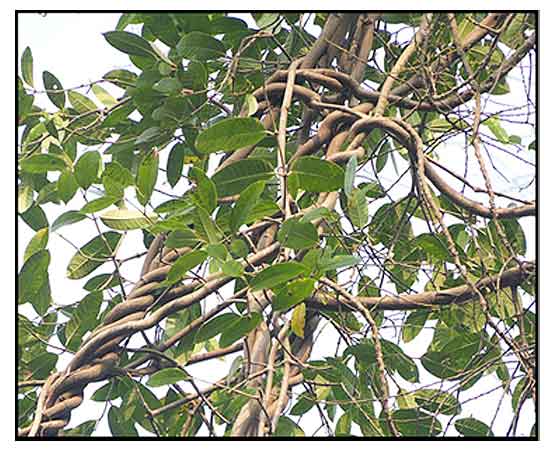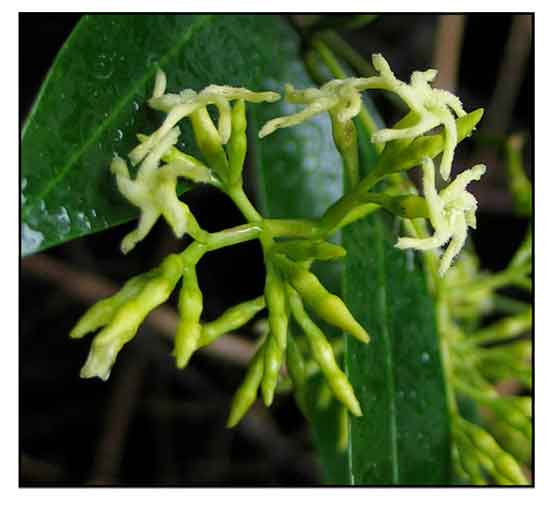 Gen info Gen info
- Anodendron parviflorum is a species of flowering plant in the family Apocynaceae, native to tropical Asia. It was first described by William Roxburg in 1832 as Echites parviflorus. (3)
- Etymology: The genus name Anodendron derives from Greek words ano (climbing) and dendron (tree), referring to the habit. The species epithet parviflorum derives from Latin words parvi (small) and florum (flower) referring to the small flowers.
Botany
Anodendron paniculatum is a glabrous liana. Leaves with petiole up to 2.5 cm long; blade elliptical to obovate, 14-28 cm × 1-10 cm (2-4.5 times as long as wide), base cuneate to rounded, apex acuminate, lateral veins 8-18 pairs. Inflorescence 5-15 cm long; pedicel 1.5-3 mm long; sepals about 1 mm long; petals whitish-yellow, glabrous outside, pubescent inside, tube 1-3 mm long, lobes 2-4 mm long; stamens inserted up to 1 mm from corolla base; disk 0.3 mm in diameter; pistil 1-1.5 mm long. Fruit 8-16 cm × 1-3 cm. Seed up to 22 mm × 9 mm, beak 6-17 mm long, coma 5-9 cm long.
(2)
Distribution
- Native to the Philippines.
- Also native to Andaman Is., Assam, Bangladesh, Borneo, Cambodia, India, Jawa, Laos, Lesser Sunda Is., Malaya, Maluku, Myanmar, Nicobar Is., Sri Lanka, Sulawesi, Sumatera, Thailand, Vietnam. (1)
- Along streams and secondary forests up to 1,700 m.
 Constituents Constituents
- Study of aerial parts isolated a new triterpene, anopaniester (1), cycloartenol (2), ursolic acid (3), esculenic acid (4), bis-(2-ethylhexyl) phthalate (5), desmosterol (6), stigmasterol (7), vaniline (8), ad (E)-phytol (9). (see study below) (4)
- A methanol extract of aerial parts yielded alkaloids, terpenoids, phenols and flavonoids, with high amounts of terpenoids (41.19 mg linalool/g). (see study below)
(5)
- Methanol extract of calli showed high contents of total phenol and alkaloid, 25.53 and 25.98 mg/g, respectively.
(see study below) (6)
- Qualitative phytochemmical screening methanolic extract of bark yielded alkaloids, triterpenoids, flavonoids, tannins, phenolics, saponins, carbohydrates, glycosides, proteins and amino acids. GC-MS analysis revealed 16 bioactive compounds, including 3-O-Methyl-d-glucose, γ-Sitosterol, n-Hexadecenoic acid, stigmasterol, squalene, campesterol etc. (7)
- Study of aerial parts of A. paniculatum isolated three triterpenes, namely ursolic acid (1), esculentic acid (2), cycloarteno0l (3), and one sterol, desmosterol (4).
(see study below) (8)
Properties
- Studies have suggested cytotoxic, anticancer, antibacterial properties.
 Parts used Parts used
Leaves, aerial parts.
Uses
Folkloric
- Dayak in Kalimantan boil the bast to use as medicine for ulcers.
- In India, roots used for treatment of vomiting and cough. Latex used for treatment of snake bites and centipede bites. (5)
Others
- Fiber: Fiber is fine, strong, and durable. In the Moluccas, bast fiber made into fishing nets and bow-strings. In Kalimantan, mainly used for fishing nets. In Malaysia, bast used for tying. In Indo-China, fiber used as sewing thread. In Java, twisted stems used as coarse tying material. (2)
Studies
• Cytotoxicity / Anticancer / Aerial Parts: Study of aerial parts isolated a new triterpene, anopaniester (1), cycloartenol (2), ursolic acid (3), esculenic acid (4), bis-(2-ethylhexyl) phthalate (5), desmosterol (6), stigmasterol (7), vaniline (8), ad (E)-phytol (9). Compounds 3 and 6 showed significant inhibitory effect (IC50s ranging from 30.89 to 44.37 µg/ml) against human cancer cell lines LU-1 and MKN-7. (4)
• Antibacterial / Aerial Parts: Study of evaluated extracts of aerial parts for phytoconstituents and antimicrobial activity. A methanol extract showed highest yield of chemical constituents, with terpenoids recorded in high amounts (41.19 mg linalool/g). The ME showed high antimicrobial activity against Vibrio cholera compared to positive control. (see constituents above) (5)
• Secondary Metabolites / Antioxidant / Calli: Methanol extract of calli showed high contents of total phenol and alkaloid, 25.53 and 25.98 mg/g, respectively. The ME of tissue culture plant at higher concentrations showed betters antioxidant activity compared to reference ascorbic acid. Tissue culture extracts from methanol showed maximum scavenging activity with 231.9& at 200 µg/ml concentration, compared to adult plant extracts at 189.1%. The high calli antioxidant activity was attributed to presence of high phenolic and alkaloid contents. (see constituents above) (6)
• Cytotoxicity / Aerial Parts: Study of aerial parts of A. paniculatum isolated three triterpenes, namely ursolic acid (1), esculentic acid (2), cycloarteno0l (3), and one sterol, desmosterol (4).
Compound 1 exhibited a moderate cytotoxicity against the LU–1 and MKN–7 cell lines with IC50s of 44.37 ± 5.40 and 30.89 ± 3.60 μg/mL, respectively. Compound 4 showed moderate cytotoxic effects toward the LU–1, KB, Hep–G2, MKN–7 and SW–480 cell lines with IC50s ranging from 28.11 ± 1.95 to 41.41 ± 2.31 μg/mL. (8)
Availability
Wild-crafted. |

![]()






